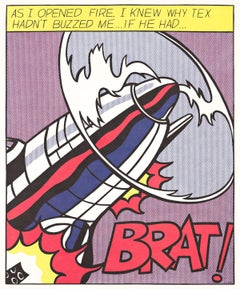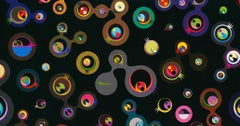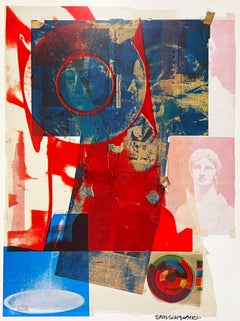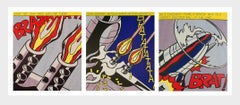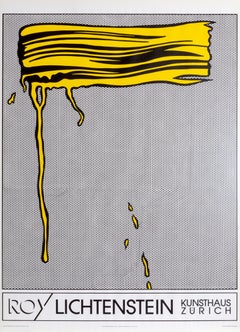(after) Roy Lichtenstein Abstract Prints
American, b. 1928
Roy Fox Lichtenstein (1923 – 1997) was an American pop artist. During the 1960s, he became a leading figure in the new art movement. He was heavily inspired by the comic strip as a visual medium, in particular the presence of the "Ben-Day" dots that are a result of the color and tone distillation of inexpensive printing. He described pop art as "not 'American' painting but actually industrial painting". Lichtenstein had his first one-man show in New York in 1962; the entire collection was bought by influential collectors before the show even opened.
He would never take himself too seriously: "I think my work is different from comic strips — but I wouldn't call it transformation; I don't think that whatever is meant by it is important to art." When first exhibited, many art critics challenged its originality. His work was harshly criticized as vulgar and empty. The title of a Life magazine article in 1964 asked, “Is He the Worst Artist in the U.S.?” Lichtenstein responded to these claims by offering responses such as: "The closer my work is to the original, the more threatening and critical the content. However, my work is entirely transformed in that my purpose and perception are entirely different. I think my paintings are critically transformed, but it would be difficult to prove it by any rational line of argument."to
1
Overall Width
to
Overall Height
to
1
14
646
200
166
165
1
1
1
1
1
1
Artist: (after) Roy Lichtenstein
As I Opened Fire Poster, Triptych
By (after) Roy Lichtenstein
Located in New York, NY
Set of 3 color offset lithographs. The last panel is signed in pencil. Printed by Drukkerij Luii & Co., Amsterdam. Published by the Stedelijk Museum, Amsterdam. This is a reproductio...
Category
1960s Pop Art (after) Roy Lichtenstein Abstract Prints
Materials
Color, Lithograph, Offset
Related Items
Takashi Murakami Kanye West 2007 (Takashi Murakami Louis Vuitton)
By Takashi Murakami
Located in NEW YORK, NY
Takashi Murakami, Kanye West, Louis Vuitton; Los Angeles 2007 (Murakami Gala):
Rare folding invitation published on the occasion of a 2007 reception honoring Takashi Murakami and fashion icon Marc Jacobs with a special performance by Kanye West; October 28th, 2007; MOCA Los Angeles; hosted by Louis Vuitton. Front side imagery features a reproduction of Murakami’s ‘Jellyfish...
Category
21st Century and Contemporary Pop Art (after) Roy Lichtenstein Abstract Prints
Materials
Offset, Paper
Quarry
By Robert Rauschenberg
Located in Washington, DC
Artist: Robert Rauschenberg
Title: Quarry
Medium: Offset lithograph in colors
Year: 1968
Edition: 500
Frame Size: 41 1/2" x 33"
Sheet Size: 35 1/2" x 26 1/2"
Signature: Signed in the...
Category
1960s Pop Art (after) Roy Lichtenstein Abstract Prints
Materials
Lithograph
Takashi Murakami record art 2018 (Takashi Murakami Kanye West)
By Takashi Murakami
Located in NEW YORK, NY
Takashi Murakami Record Art 2018 (Takashi Murakami Kanye West Kid Cudi):
This Takashi Murakami designed cover & record album is for Kids See Ghosts and is the only studio album by t...
Category
21st Century and Contemporary Pop Art (after) Roy Lichtenstein Abstract Prints
Materials
Paper, Offset
Robert Rauschenberg, rare 1970s Signed/N Earth Day William Burroughs lithograph
By Robert Rauschenberg
Located in New York, NY
ROBERT RAUSCHENBERG
Dream of William Burroughs, 1972
Offset lithograph
34 1/2 × 24 inches
Edition 103/150
Signed, dated and numbered in black marker on the front
Unframed
Wonderful e...
Category
1970s Pop Art (after) Roy Lichtenstein Abstract Prints
Materials
Lithograph, Offset
Takashi Murakami 'Superflat' exhibition poster (vintage Takashi Murakami)
By Takashi Murakami
Located in NEW YORK, NY
Takashi Murakami Superflat Exhibition Poster 1999:
Rare 1990s exhibit poster designed by Murakami and published by Marianne Boesky Gallery New York...
Category
21st Century and Contemporary Pop Art (after) Roy Lichtenstein Abstract Prints
Materials
Lithograph, Offset
$375 Sale Price
31% Off
H 22 in W 17 in D 0.01 in
Vintage Frank Stella poster Democratic Convention 1980 colorful Pop political
By Frank Stella
Located in New York, NY
Colorful vintage poster for the 1980 Democratic National Convention, held in Madison Square Garden in New York.Concentric lines of orange and bright green interweave with strokes of pink, yellow, red, turquoise, silver, and gold. Printed with metallic ink that catches light differently from each angle, complementing the poster’s lime green and red text. The top of the poster reads “Let us move forward with a strong and active faith.”
It was at this 1980 convention that Jimmy Carter was nominated for reelection. This large poster was printed by Petersburg Press in 1980, and features Frank Stella’s Polar...
Category
1980s Pop Art (after) Roy Lichtenstein Abstract Prints
Materials
Lithograph
Marching On A Butterbur Leaf Print 2019 Exclusive Limited Sticker Set Pop Art
By Yoshitomo Nara
Located in Draper, UT
DETAILS:
27 x 17 inches 2020
Offset lithograph
80# Classic Linen Solar White Cover
Category
2010s Pop Art (after) Roy Lichtenstein Abstract Prints
Materials
Lithograph
Takashi Murakami - Let us Devote Our Hearts, bright pink colors and flowers
By Takashi Murakami
Located in Dallas, TX
This collectible work on paper by Murakami is edition # 78 of 300. It comes unframed.
One of the most acclaimed artists to emerge from post-war Asia, Takashi Murakami is known for h...
Category
2010s Pop Art (after) Roy Lichtenstein Abstract Prints
Materials
Paper, Varnish, Offset
Nara Girl Banging On A Drum With Limited Edition Sticker Set Pop Art Print
By Yoshitomo Nara
Located in Draper, UT
Banging the Drum
DETAILS
27 x 17 inches (unframed), 2020
Offset lithograph
80# Classic Linen Solar White Cover
Category
2010s Pop Art (after) Roy Lichtenstein Abstract Prints
Materials
Lithograph
Study for Sculpture in the Form of an Inverted Q Above & Below Ground Oldenburg
By Claes Oldenburg
Located in New York, NY
Study for Sculpture in the Form of an Inverted Q: Above and Below Ground, 1975
Lithograph, soft-ground etching, and aquatint in six colors on cream, thick, slightly textured Rive BFK paper
14 × 11 in. / 35.2 × 28 cm
Signed and dated in pencil, lower right, numbered in pencil, lower left. Edition of 100 with 20 AP. Printed by Bill Law, Winston Roeth and Allan Uglow at Petersburg Press...
Category
1970s Pop Art (after) Roy Lichtenstein Abstract Prints
Materials
Etching, Aquatint, Lithograph
Vintage James Rosenquist poster MOCA Chicago 1972 neon yellow pink chrome
By James Rosenquist
Located in New York, NY
An inverted car, gleaming in chrome, speeds through sumptuous layers of pink, translucent yellow, and a veil of lacy, flower-like shapes. Across the top, the artist’s name is splashe...
Category
1970s Pop Art (after) Roy Lichtenstein Abstract Prints
Materials
Offset
1-2-3 Outside James Rosenquist pop art muscle car print blue and orange
By James Rosenquist
Located in New York, NY
1-2-3 Outside reproduces James Rosenquist’s 1963 oil painting of the same name, collected in the Spencer Museum of Art, The University of Kansas, Lawrence. Rosenquist sourced the ima...
Category
1970s Pop Art (after) Roy Lichtenstein Abstract Prints
Materials
Lithograph
Previously Available Items
Roy Lichtenstein As I Opened Fire (set of 3 lithographic posters)
By (after) Roy Lichtenstein
Located in NEW YORK, NY
Roy Lichtenstein As I Opened Fire, set of 3 Lithographic Posters:
An authorized reproduction of Roy Lichtenstein's painting entitled "As...
Category
1960s Contemporary (after) Roy Lichtenstein Abstract Prints
Materials
Lithograph, Offset
Yellow Brushstroke
By (after) Roy Lichtenstein
Located in Long Island City, NY
A vintage poster of Roy Lichtenstein's "Yellow Brushstroke" for an exhibition at Kunsthaus Zurich, printed in Bonn, Germany 1990. unframed.
Category
1990s Pop Art (after) Roy Lichtenstein Abstract Prints
Materials
Screen
Landscape
By (after) Roy Lichtenstein
Located in Long Island City, NY
A vintage poster of Roy Lichtenstein's "Landscape" for an exhibition at Guild Hall, East Hampton. Edition size 1000. Unframed.
Category
1980s Pop Art (after) Roy Lichtenstein Abstract Prints
Materials
Screen
Yellow Brushstroke
By (after) Roy Lichtenstein
Located in Long Island City, NY
A vintage poster of Roy Lichtenstein's "Yellow Brushstroke" for an exhibition at Kunsthaus Zurich, printed in Bonn, Germany 1990. unframed.
Category
1990s Pop Art (after) Roy Lichtenstein Abstract Prints
Materials
Screen
(after) Roy Lichtenstein abstract prints for sale on 1stDibs.
Find a wide variety of authentic (after) Roy Lichtenstein abstract prints available for sale on 1stDibs. You can also browse by medium to find art by (after) Roy Lichtenstein in lithograph, offset print and more. Much of the original work by this artist or collective was created during the 1960s and is mostly associated with the Pop Art style. Not every interior allows for large (after) Roy Lichtenstein abstract prints, so small editions measuring 6 inches across are available. (after) Roy Lichtenstein abstract prints prices can differ depending upon medium, time period and other attributes. On 1stDibs, the price for these items starts at $345 and tops out at $12,000, while the average work can sell for $6,173.
Questions About (after) Roy Lichtenstein Abstract Prints
- Who is Roy Lichtenstein?1 Answer1stDibs ExpertMarch 22, 2022Roy Lichtenstein is an American artist who helped to shape the Pop art movement. He was born on October 27, 1923 in New York City, and he died there on September 29, 1997. Some of his most famous works include Whaam!, Drowning Girl and two different pieces titled Crying Girl. On 1stDibs, find a selection of Roy Lichtenstein art.
- Where is Roy Lichtenstein from?1 Answer1stDibs ExpertMarch 22, 2022Roy Lichtenstein is from New York City, New York. He was born in Manhattan on October 27, 1923, and he died in the city on September 29, 1997. Lichtenstein attended Ohio State University in Columbus, Ohio. On 1stDibs, find a range of Roy Lichtenstein art.
- Why was Roy Lichtenstein famous?1 Answer1stDibs ExpertApril 5, 2022Roy Lichtenstein was famous for his remarkable work in pop art, perhaps most notably, his comic book-style paintings. His work is renowned for its sense of parody. Shop a collection of Roy Lichtenstein pieces and prints from top sellers around the world on 1stDibs.
- 1stDibs ExpertMarch 22, 2022Roy Lichtenstein was important to the art world because he helped pioneer Pop art. This movement focused on incorporating images from pop culture and mass media into fine art. His work continues to influence contemporary artists like Richard Bell and Grégoire Guillemin to this day. Shop a collection of Roy Lichtenstein art on 1stDibs.
- What inspired Roy Lichtenstein?1 Answer1stDibs ExpertMarch 22, 2022Advertising and comic books inspired Roy Lichtenstein to create art. In fact, many of his pieces appropriated images from these sources, transforming them into commentaries on geopolitics and social issues. On 1stDibs, you can shop a collection of Roy Lichtenstein art.
- 1stDibs ExpertApril 5, 2022To authenticate Roy Lichtenstein art, consult the help of a licensed art appraiser with experience identifying Pop art. Due to the number of high quality giclée prints available, it is very difficult to verify that an artwork is real and not a reproduction. Shop a collection of expertly vetted Roy Lichtenstein art on 1stDibs.
- 1stDibs ExpertMarch 22, 2022To pronounce Roy Lichtenstein, say, "Roy LICK-ton-stine." The artist's last name is of German origin. He was a leader of the Pop art movement who lived from 1923 to 1997. On 1stDibs, you can shop a variety of Roy Lichtenstein art.
- 1stDibs ExpertMarch 22, 2022Roy Lichtenstein influenced a number of contemporary artists, including Richard Bell, Grégoire Guillemin and Douglas Coupland. During his lifetime, he also inspired other Pop art artists like Andy Warhol, James Rosenquist and Claes Oldenburg. Shop a variety of Roy Lichtenstein art on 1stDibs.
- 1stDibs ExpertMarch 22, 2022Roy Lichtenstein studied art at Ohio State University. He received both Bachelor and Master of Fine Arts degrees from the university. For 10 years, he worked as an instructor at the institution. Find a range of Roy Lichtenstein art on 1stDibs.
- 1stDibs ExpertApril 5, 2024Roy Lichtenstein made his art by using comic books and advertisements as sources. He took images from pop culture and then painted them using Magna acrylic paints that had a flat finish that mimicked the look of printing inks. The Pop artist worked mostly in primary colors and employed thick lines and Ben-Day dots to give his work a cartoon-like quality. Shop a selection of Roy Lichtenstein art on 1stDibs.
- 1stDibs ExpertApril 5, 2022Yes, Roy Lichtenstein did indeed use appropriation in his art. In this case, ‘appropriation’ in art is the use of existing objects or images with little or no transformation applied to them. One of Lichtenstein’s most famous pieces is ‘Look Mickey’ featuring Mickey Mouse and Donald Duck. Shop a selection of Roy Lichtenstein’s pieces from some of the world’s top art dealers on 1stDibs.
- 1stDibs ExpertMarch 22, 2022Roy Lichtenstein used patterns of dots to give his Pop art paintings the look of mass-printed graphics. To create this effect, he placed a stencil covered with perforated dots and brushed paint over the back. On 1stDibs, shop a collection of Roy Lichtenstein art.
- 1stDibs ExpertJune 6, 2024Roy Lichtenstein's art style was Pop art. In fact, he is one of the principal figures of the American Pop art movement, along with Andy Warhol, James Rosenquist, Claes Oldenburg and Robert Rauschenberg. Drawing inspiration from comic strips, Lichtenstein appropriated techniques of commercial printing in his paintings, introducing a vernacular sensibility to contemporary art. He employed visual elements such as the halftone dots that comprise a printed image and a comic-inspired use of primary colors to give his paintings their signature "Pop" palette. On 1stDibs, shop a selection of Roy Lichtenstein art.
- Is Roy Lichtenstein still alive?1 Answer1stDibs ExpertFebruary 22, 2021No, Pop artist Roy Lichtenstein is not alive. He died at the age of 73 in 1997. You can find Roy Lichtenstein's art on 1stDibs.
- 1stDibs ExpertMarch 22, 2022Roy Lichtenstein has a large number of famous paintings. The most famous include Whaam!, Drowning Girl, Look Mickey, M-Maybe, In the Car, Masterpiece, Crak!, and two separate works titled Crying Girl. You'll find a selection of Roy Lichtenstein art on 1stDibs.
- 1stDibs ExpertMarch 25, 2024Roy Lichtenstein's most popular piece of art is a matter of opinion. One contender for the title is his 1963 diptych painting Whaam!, which has a scene of a fighter plane hitting another plane with a rocket from a 1962 issue of DC Comics’s series All American Men of War. Another of his well-known works is Crying Girl from the same year. It features a woman in distress, depicted with a mixture of drama and deadpan humor. Other famous works by Lichtenstein include Drowning Girl, Look Mickey, M-Maybe, In the Car and Masterpiece. Find a collection of Roy Lichtenstein art on 1stDibs.
- 1stDibs ExpertMarch 22, 2022Roy Lichtenstein mainly used red, blue, yellow and green in his work. Lichtenstein chose these colors because they are the primary ones used in printing, and he patterned his pieces after advertisements and comic books. On 1stDibs, shop a selection of Roy Lichtenstein art.
 David Brooker Fine ArtMay 13, 2021large oils are worth many millions of dollars. The value would depend on the size, composition and importance of the piece.
David Brooker Fine ArtMay 13, 2021large oils are worth many millions of dollars. The value would depend on the size, composition and importance of the piece.- 1stDibs ExpertMarch 22, 2022Roy Lichtenstein created many paintings before he died in 1997. Historians estimate that he made more than 5,000 paintings, drawings, prints, sculptures and other pieces. Some of his most well-known works include Crying Girl, Drowning Girl and Whaam! Shop a range of Roy Lichtenstein art on 1stDibs.
- 1stDibs ExpertMarch 22, 2022No, Roy Lichtenstein did not paint Wonder Woman. However, other artists depicted the character in his style. Lichtenstein did use comic books for inspiration. For example, the 1962 issue of “All-American Men of War” from DC Comics was the source for his painting Whaam! Find a collection of Roy Lichtenstein art on 1stDibs.
